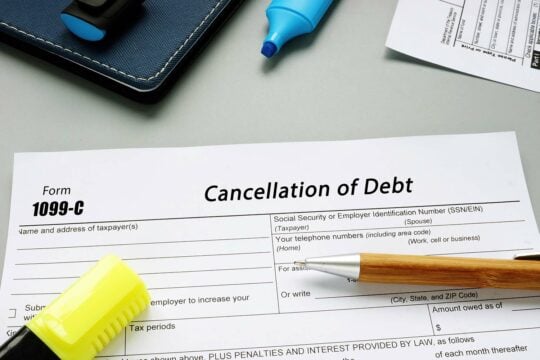Do you know that money your company takes out of your paycheck to pay taxes? That’s called tax withholding.
The money that employers are legally required to take out of their employees’ paychecks is automatically put toward federal income taxes. Doing this prevents you from owing the IRS money come tax filing season.
As an employee, you can adjust how much is withheld depending on how you fill out Form W-4. You should receive this upon hire (unless you’re an independent contractor) so you can specify how much tax you want withheld from your gross pay.
Depending on filing status, dependents, anticipated tax credits, and deductions, it’s possible to tell your employer not to withhold any taxes at all.
If too much tax is withheld, you get a refund. When too little tax is withheld, you’ll end up owing money to the IRS and potentially lose any flexibility on how you pay your taxes in the future.
Estimate your owed federal and state taxes based off your taxable income.
What happens if I did not withhold enough taxes on my W-4?
Not paying the right amount of taxes can be difficult to deal with, especially come tax season. Julie Farah, a tax attorney at , confirms that people generally do not consider saving money to use for their taxes.
“It is true that you may owe the IRS if you don’t withhold enough taxes through your employer,” Farah says. “The amount of tax debt owed will vary depending on your income and the amount withheld. The IRS typically does not waive tax debt that resulted from withholding mistakes.”
If you repeatedly under-withhold tax on your checks and accrue tax debt, the IRS can send a “lock-in” letter to your employer. This forces you to withhold at the highest tax rate, taking away your flexibility when it comes to paying taxes.
What is an IRS lock-in letter?
Form 2802C is a letter sent by the IRS notifying you when your tax withholdings don’t comply with guidelines and need to be increased. You get 30 days to self-correct your W-4 or appeal this decision. Your employer then has an additional 30 days to update your withholdings. You can review the form on the IRS website here.
Failure to adjust your W-4 withholdings will result in your employer being issued a 2800C “lock-in letter”. This form instructs employers to withhold federal income tax at the maximum rate (single marital status and zero withholding allowances) effective immediately.
Additionally, employers must disregard any revised W-4s submitted by the employee that decreases the amount of withholding.
You can request to be released from the Withholding Compliance Program after timely tax filing and payment for three consecutive years. Your employer will receive a 2813C letter notifying them that you have been released from the lock-in. At that point, you can submit a new Form W-4.
What happens if I withheld too much?
If too much tax is being withheld from your paycheck, you will end up getting a tax refund. While it can be fun receiving a big pile of money once a year, overpaying taxes is not the smartest financial move.
Why? Because getting a tax refund means more money was taken out of your paychecks than necessary, so you miss out on paying off debt sooner (and cheaper) or investing it to earn interest. Both of these alternatives are more financially beneficial in the long run.
Ideally, aim to owe nothing and receive nothing.
When should I change my tax withholding?
Take a look at the total line on last year’s return. The bigger the number, whether positive or negative, the more likely an adjustment is in order.
Other situations can prompt a change in tax liability, including:
- Unemployment or self-employment for part of the year
- Working multiple jobs
- Spouse switching jobs
- Marriage or divorce
- Having a baby
- Child files their own taxes
- Income from interest, dividends, alimony, or unemployment benefits
Basically, you should revisit your W-4 after any major change in your life.
How do I change my payroll tax withholding?
You can file a new W-4 with your employer at any time, usually through your HR department. Like nearly everything tax, the W-4 form can be tricky to complete correctly!
You will also need to coordinate with your spouse so you don’t overclaim household exemptions.
To complete Form W-4 successfully, think in terms of your tax return and not in terms of real life. For example, consider your filing status and not just your marital status. If you and your spouse file jointly, select “Married” on your W-4. If you file separately, select “Married, but withhold at a higher Single rate.”
Also keep in mind that if you aren’t going to claim someone as a dependent on your tax return, don’t figure them into your W-4 either.
Try to take advantage of all possible tax exemptions on your W-4 for the job that pays the most money to you. If you have multiple jobs, your secondary, lower paying jobs’ W-4s should be completed with 0 exemptions and taxed at the highest tax rate. This will prevent any unexpected tax bills come filing time.
The IRS has a withholding calculator to help you find the right balance. To get the most accurate results, you’ll want to have recent pay stubs and your last tax return on hand.
What if I’m a freelancer?
When you are employed by someone else, they are responsible for following your preferences for tax withholding. If you’re an independent contractor or self-employed, however, you take care of your own taxes. Set aside enough money from your freelance income. If you don’t, you can accrue tax debt.
The amount you need to set aside for taxes depends on how much you make. If you work full-time but also have a side gig, don’t assume that your W-4 will cover the taxes for both. Review how freelance taxes work to ensure you aren’t missing anything important.
Should I check my withholding now before the end of the year?
If your 2023 tax return didn’t turn out the way you had hoped, experts at Debt.com recommend checking and possibly updating your payroll tax withholding. This is crucial if you owed more or less than you thought you would, experienced a significant life event, or made any changes to your withholding last year.
You should also look into recent tax reform laws, like the latest tax inflation adjustments.
There is still time before the end of the year to make adjustments. If you increase your payroll tax withholding now, you can make up the difference and avoid tax debt next tax filing season.







